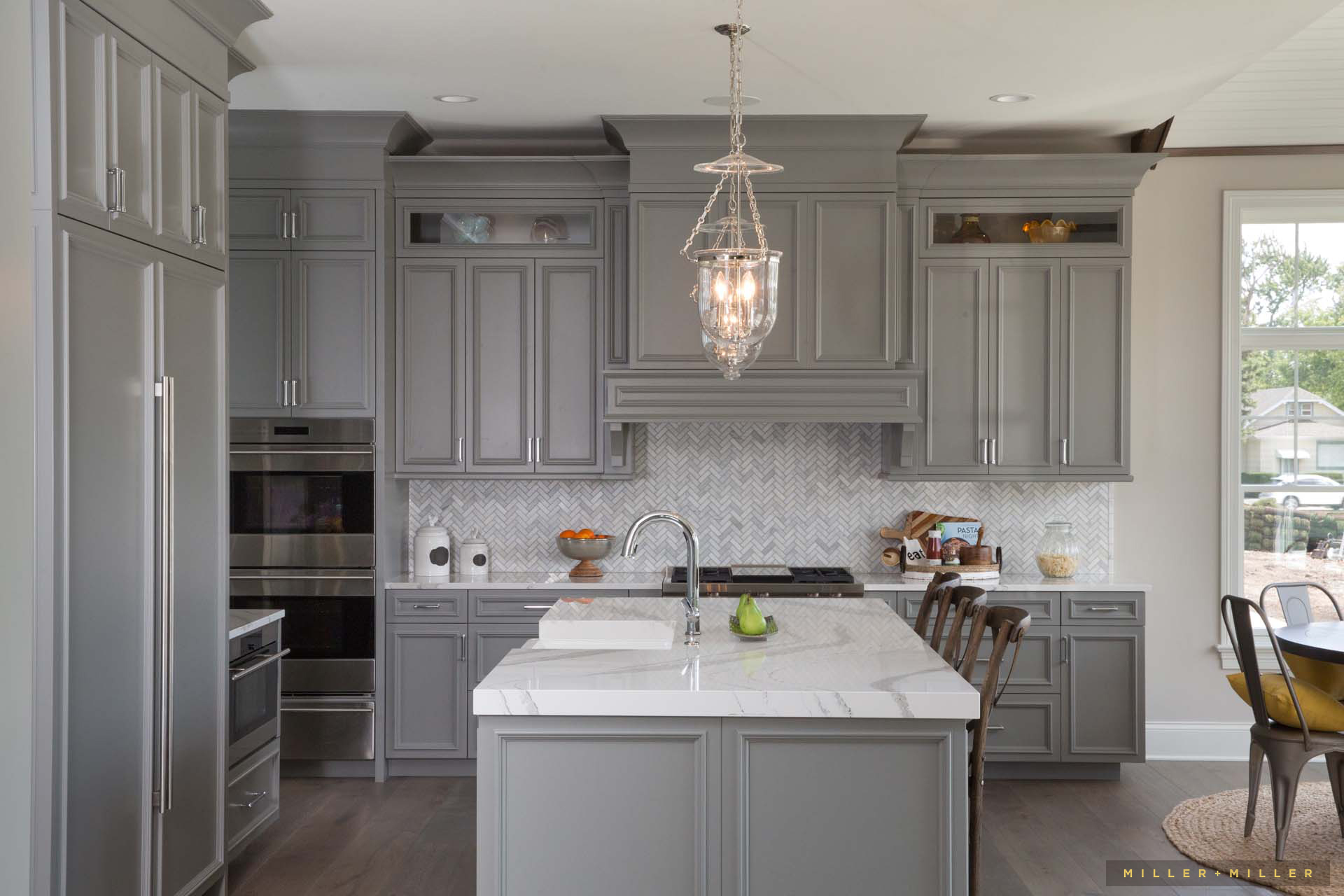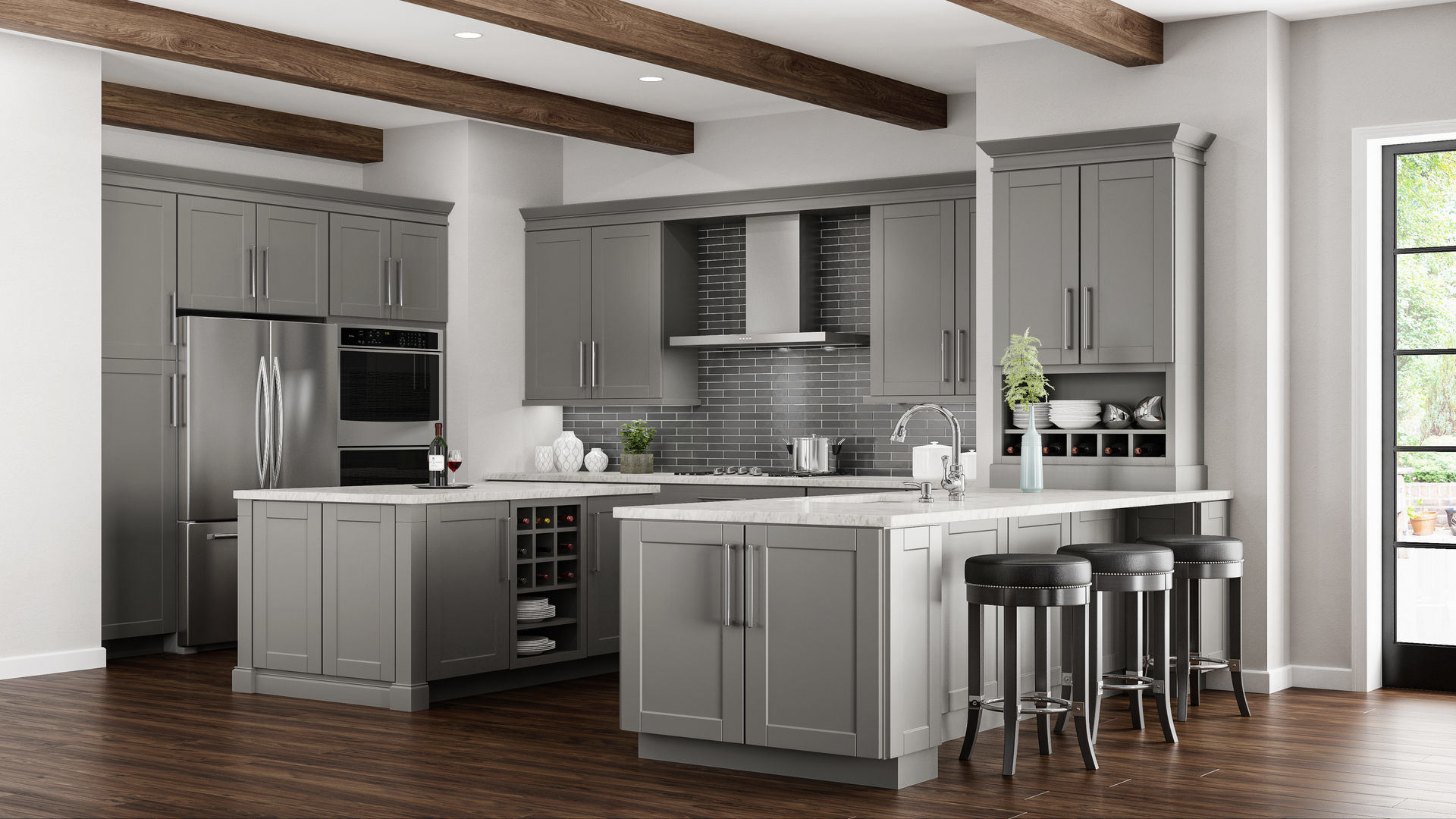Design Trends in Contemporary Gray Kitchen Cabinets

Gray kitchen cabinets have transcended a fleeting trend, evolving into a sophisticated staple in modern home design. Their enduring appeal stems from their versatility, effortlessly blending with various styles and palettes, from minimalist chic to rustic warmth. This chameleon-like quality, coupled with a sense of understated elegance, continues to drive their popularity.
Popular Styles of Gray Kitchen Cabinets
The spectrum of gray kitchen cabinet styles is vast, reflecting a diverse range of materials and finishes. The choice often hinges on the desired aesthetic and the overall design of the kitchen. Consider these examples:
| Style | Material | Finish | Notable Features |
|---|---|---|---|
| Shaker | Solid wood (oak, maple) | Matte | Simple, clean lines; timeless appeal; versatile for various styles. |
| Slab | Thermofoil, MDF | High-gloss | Sleek, modern look; easy to clean; reflective surfaces amplify light. |
| Modern Farmhouse | Reclaimed wood | Distressed | Rustic charm; unique character; blends traditional and contemporary elements. |
| Transitional | Painted MDF | Semi-gloss | Balance of traditional and contemporary details; adaptable to diverse styles. |
Evolution of Gray Kitchen Cabinets
The journey of gray kitchen cabinets from traditional to modern designs is a testament to their adaptability.
Contemporary gray kitchen cabinets – The evolution can be summarized as follows:
- Traditional Gray: Initially, gray was used sparingly, often in more formal settings, appearing as a muted background color in kitchens dominated by darker wood tones or bolder accent colors. The finishes were typically more traditional, such as a satin or eggshell.
- Transitional Phase: The rise of transitional design blurred the lines. Gray started to gain prominence, featuring in both cabinetry and walls, often paired with warmer neutrals like beige or cream. Finishes remained somewhat muted, but more variety began to emerge.
- Contemporary Gray: The contemporary era embraces a wider spectrum of grays, from cool, almost blue-toned shades to warmer, greige hues. The use of bold contrasts, mixed materials, and diverse finishes (matte, high-gloss, distressed) has become commonplace.
Shades of Gray and Their Impact on Kitchen Mood
The subtle differences between shades of gray significantly impact the overall atmosphere of a kitchen.
Different shades evoke different feelings:
- Light Gray: Creates an airy, spacious feel, ideal for smaller kitchens. It provides a neutral backdrop that allows other design elements to shine.
- Medium Gray: Offers a balanced approach, neither too light nor too dark. It’s versatile and works well with various styles and color palettes.
- Dark Gray: Adds drama and sophistication. It can make a statement, particularly in larger kitchens where it won’t feel overwhelming. It can also create a more intimate, cozy atmosphere.
- Greige (Gray-Beige): Warmer than pure gray, greige offers a comforting and inviting ambiance, blending seamlessly with natural materials like wood.
Contrasting Colors and Materials with Gray Cabinets
Gray’s neutral nature makes it an excellent canvas for contrasting elements.
Consider these examples of successful pairings:
- White Countertops and Backsplash: A classic combination that creates a clean, bright, and airy feel. The white brightens the gray, preventing it from feeling too somber.
- Warm Wood Accents: Pairing gray cabinets with warm wood tones, such as oak or walnut, introduces texture and visual interest, balancing the coolness of the gray. This creates a sophisticated, yet inviting atmosphere.
- Bold Island Color: Painting the kitchen island a contrasting color, such as a deep navy, emerald green, or even a bright yellow, adds a pop of personality and visual interest to the space.
- Metallic Hardware: Brass, gold, or copper hardware can add warmth and sophistication, complementing the gray cabinets and adding a touch of luxury.
Integrating Contemporary Gray Cabinets into Different Kitchen Styles: Contemporary Gray Kitchen Cabinets

The allure of contemporary gray kitchen cabinets lies in their versatility. Far from being a monolithic choice, gray acts as a chameleon, adapting seamlessly to a spectrum of kitchen styles, from the rustic charm of a farmhouse to the sleek minimalism of a modern design. The key lies in understanding how to harmonize the gray with complementary elements, creating a cohesive and aesthetically pleasing space.
Contemporary Gray Cabinets in Farmhouse Kitchens
The juxtaposition of cool gray cabinets against the warm textures of a farmhouse kitchen creates a captivating contrast. This style embraces the imperfect, celebrating the beauty of natural materials and handcrafted details. The gray cabinets provide a grounding element, preventing the space from feeling overly rustic or cluttered.
| Style | Cabinetry | Countertop | Flooring | Backsplash |
|---|---|---|---|---|
| Farmhouse | Contemporary gray shaker-style cabinets | White marble or butcher block | Wide-plank wood flooring in a light, warm tone | White subway tile or a patterned tile with a rustic feel |
Appropriate hardware and lighting choices are crucial in achieving the desired farmhouse aesthetic.
- Hardware: Black or oil-rubbed bronze pulls and knobs add a touch of rustic elegance, complementing the gray cabinets and grounding the overall design.
- Lighting: A combination of pendant lights above the island, recessed lighting for general illumination, and possibly a statement chandelier to enhance the farmhouse feel. Warm-toned lighting is preferred to complement the wood and stone elements.
Incorporating natural elements is essential for a successful farmhouse design.
- Natural wood open shelving adds warmth and visual interest, displaying cherished crockery and kitchenware. A large wooden island provides a central gathering point, enhancing the kitchen’s rustic charm.
- Stone countertops, such as marble or butcher block, provide a beautiful contrast to the gray cabinets, adding a touch of natural texture and elegance.
Contemporary Gray Cabinets in Minimalist Kitchens, Contemporary gray kitchen cabinets
Minimalist kitchens prioritize clean lines, functionality, and a sense of spaciousness. Gray cabinets, particularly in a sleek, flat-panel design, contribute perfectly to this aesthetic. The muted tone provides a neutral backdrop, allowing other design elements to take center stage.
| Style | Cabinetry | Countertop | Flooring | Backsplash |
|---|---|---|---|---|
| Minimalist | Contemporary gray flat-panel cabinets | White quartz or concrete | Large-format porcelain tiles in a light neutral shade | Simple, white or light-gray groutless tile |
Hardware and lighting in a minimalist kitchen should be understated yet effective.
- Hardware: Sleek, minimalist bar pulls in brushed nickel or stainless steel maintain the clean lines of the design. Avoid ornate or overly decorative hardware.
- Lighting: Recessed lighting provides even illumination, while under-cabinet lighting highlights countertops and workspaces. Consider integrated LED strip lighting for a subtle, modern touch.
While minimalism prioritizes simplicity, strategic use of natural elements can add depth and warmth without compromising the overall aesthetic.
- A single, carefully chosen piece of wood, such as a live-edge countertop detail or a wooden cutting board, introduces a natural element without overwhelming the space. Similarly, a stone backsplash with subtle veining can add visual interest.
Contemporary Gray Cabinets in Transitional Kitchens
Transitional kitchens skillfully blend elements of traditional and contemporary styles, creating a balanced and sophisticated look. Gray cabinets act as a bridge, allowing for the incorporation of both traditional and modern features without clashing.
| Style | Cabinetry | Countertop | Flooring | Backsplash |
|---|---|---|---|---|
| Transitional | Contemporary gray cabinets with raised-panel doors | Light-colored granite or quartz | Hardwood flooring in a medium-toned stain | Classic white subway tile or a neutral-toned mosaic |
Hardware and lighting choices in a transitional kitchen should reflect the balance between traditional and modern aesthetics.
- Hardware: Simple, yet elegant knobs or pulls in brushed nickel or oil-rubbed bronze create a refined look. The hardware should complement the cabinet style without being overly ornate or minimalist.
- Lighting: A combination of pendant lights, recessed lighting, and possibly a statement light fixture above the island, provides ample illumination. The lighting should be neither overly warm nor overly cool, maintaining a balanced atmosphere.
The incorporation of natural elements in a transitional kitchen helps to soften the overall look and add a touch of warmth.
- A wooden island with a waterfall edge adds a touch of traditional elegance while maintaining a contemporary feel. Stone countertops, such as granite or quartz, offer durability and visual appeal, enhancing the kitchen’s sophistication.
Imagine a kitchen where the gray cabinets, a soft dove gray with a subtle linen texture, are accented by a honed Carrara marble countertop. The backsplash is a mesmerizing mosaic of deep teal and gold, creating a focal point that catches the light. The warm glow of recessed lighting highlights the subtle veining in the marble and the intricate patterns in the mosaic, while pendant lights above the island cast a soft, inviting ambiance. The interplay of light and shadow, texture and pattern, creates a kitchen that is both visually stunning and remarkably inviting.
